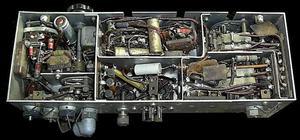Trade exhibitions are major parts of any modern scientific conference. The ‘Festival of Neuroscience’ organised by the British Neuroscience Association at the Barbican in London in April 2013 attracted more than 70 exhibitors demonstrating cutting edge technology over two floors of the Barbican Exhibition halls. From routine consumables (and I’m not just talking about the first evening’s drinks reception) to sophisticated machines that perform in seconds the complex analyses that used to take me a month, a PI with a successful grant award to spend is in a veritable seventh heaven.
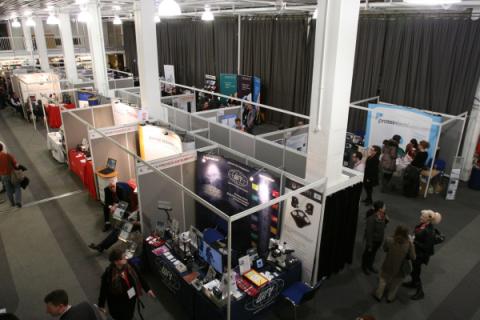
This provides an astonishing contrast to the way in which pioneer ’neuroscientists’ equipped their labs in the decades immediately after the Second World War. Buying off-the-peg apparatus was often a remote, and expensive, possibility. The first commandment for any budding physiologist was ‘make thine own equipment’. When I was a working neuroscientist in the late 1970s and 1980s, a mechanical workshop with a lathe and an electronic workshop were essential facilities. But earlier generations were not just doing their own modifications and repairs as I did – they were starting from scratch.
Dr Ann Silver was a PhD student in the mid-1950s. An Edinburgh graduate, she was invited by one of her lecturers, Catherine Hebb, to move to the Agricultural Research Council’s institute in Babraham, Cambridge, to investigate the effects of organophosphorus compounds on the nervous system. These chemicals had been used as nerve gases in the war, and were increasingly employed as insecticides, but little was known about their mode of action. One theory was that they caused demyelination of nerve fibres, and Ann’s research was to investigate the electrophysiological responses of nerves in chickens exposed to these compounds.
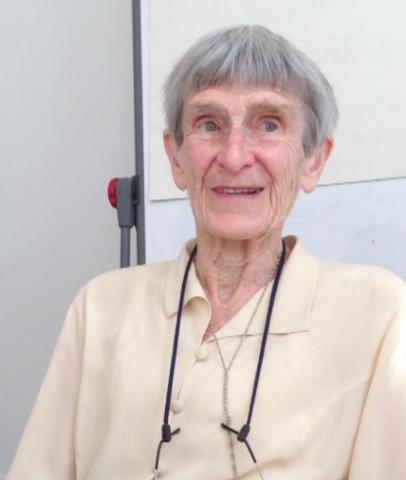
In an interview as part of the ‘Today’s Neuroscience, Tomorrow’s History’ video-project that Professor Les Iversen and I ran a few years ago, Ann recalled: ‘I stayed on for the first year in Edinburgh learning some electronics and trying to build an enormous apparatus – it was called ‘Henrietta’. This was to record … specifically to record action potentials in nerves, and it had a screen on which you could see the action potential travelling along etc, etc, and you could stimulate the nerve. You could do various things and see what the effects were, and it had all sorts of interesting components in it, called things like – in those days – wobbulators, and all sorts of funny things, and most of the components were ex-War Department surplus. And all people doing electrophysiology at that time used to build their stuff from these scrap components.’

Ex-military stock was the source of components for many a budding physiologist. Shops along Tottenham Court Road and on Lisle Street in Soho were favourite haunts, and whilst those working in London might have an advantage, the many regular meetings of the Physiological Society, at least two of which were usually held in London every year, provided ample shopping opportunities for others. Equally popular with some physiologists were the ‘rubber goods’ stockists near Kings Cross station, as condoms were used as a source of thin rubber for respiratory valves, tambours etc. Sir William Paton’s account of how the salesman’s look of admiration as he ordered a gross turned to horror, when, on asking if round or teat-ended were preferred, he received the answer ‘oh it doesn’t matter, I always cut the ends off’, has become the basis of many physiological stories.
Surprisingly, given the bespoke nature of her equipment, Ann Silver’s PhD thesis contains only one page of details about its construction, calibration and operation:
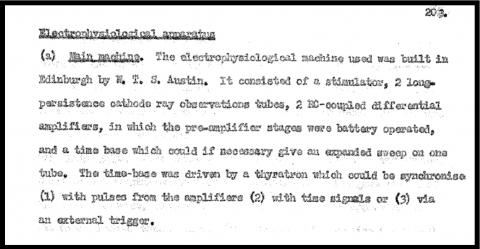
WTS ‘Jock’ Austin was then the electronics technician working for David Whitteridge, the Professor of Physiology in Edinburgh, and the person who supervised the building of Henrietta. Severely injured in a glider crash in the Second World War, Jock had residual dysphasia, which Ann recalled, combined with her own tenuous grasp of electronics, meant that she often soldered the wrong components together. Once ‘Henrietta’ - the name had nothing to do with the fact that Ann’s experimental work was on poultry - was complete, she had to be moved to her new home in Babraham. Ann takes up the story: ‘Henrietta was really rather large, and so Babraham sent our Trojan van, which went about thirty miles an hour – a top speed of thirty miles an hour – and was extremely uncomfortable, and the driver and the electronics man from Babraham trundled up to Edinburgh. Nobody had introduced them, they didn’t know what each other’s names were, and they spent about two days on the road not knowing each other’s names. They then loaded up Henrietta, drove her back to Babraham, with, luckily, all her circuit diagrams, which were exclusive to her, as so much was in those days. You built your apparatus. Only you knew what it contained.’ In a later interview Ann elaborated on some of the problems, admitting that calibration could be somewhat arbitrary; ‘your millivolt may not be the same as your neighbour’s millivolt’.
Unfortunately no photographs survive of Henrietta. Kresimir Krnjevic, Ann’s fellow PhD student and later Professor at McGill University in Montreal, had no contemporary photographs either, although he did tell us: ‘ I began my PhD research in Edinburgh (in 1951) with no previous experience in electronics and had never used a soldering iron, with intermittent guidance from Jock Austin and especially the invaluable information provided in full detail by our ‘bible’ – C.J. Dickinson’s ‘Electrophysiological Technique’, published by Electronic Engineering, London 1950 – it took only about 3 - 4 months to put together a functioning electrophysiological set-up. … Apart from the Cossor cathode ray tube, all the parts needed to construct power supplies, amplifiers, stimulators etc. – such as resistors, capacitors, diode and triode valves - were purchased (at quite low cost) from ex-army surplus stores. Even the camera was from air-force (US?) surplus …. Perhaps the (physically) hardest part of the work was making holes manually in the steel chassis on which the valves and other components were to be mounted: this required brute force and perseverance… Having to make all the equipment oneself was a great learning experience. A great advantage over ready-made commercial equipment was that one really understood what was going on in the ‘black box’ and could fix technical problems without outside help. … As far as blue-prints and/or circuits are concerned, they are all in Dickinson’s book. ’ With these helpful comments, Professor Krnjevic also forwarded a scan :
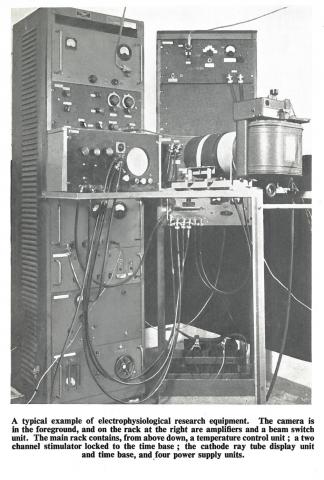
Ann Silver agreed about the influence of the book, but disagreed about the suggested figure, ‘ Yes’, she wrote, ‘Dickinson was certainly my Bible… [but] the Dickinson picture is too posh! Our apparatus tended to have trailing connections and knobs with tatty labels ... I am racking my brains about the 'finish' on the steel casing. I seem to think that after the holes were cut in the front, ready for knobs to be mounted, it was sent off somewhere to be 'finished' with a black, slightly rough, coating. I thought this was called 'deckle' but that doesn't seem to fit the dictionary definition.’
'Electrophysiological technique’ was a pioneering volume. I phoned John Dickinson, now Emeritus Professor of Medicine at QMUL, and he told me that it was, basically, the kind of book he had wanted to read and use, but because one was not available, decided to write it himself. Like many young men in the late '40s and '50s he was an avid reader of ‘Wireless World’, frequently dismantling and reassembling radios, and at one stage had built a working television from spare parts. Writing the book, which he’d done as a medical student, had been ‘fun, especially drawing the circuits.’
Sadly Henrietta herself was discarded not long after Ann finished her PhD, cannibalised for components, and never used again. Krnjevic’s apparatus fared little better. Unable to pay for its transport to Canada when he moved to McGill, he carefully stored all his equipment in an out-of-the-way garage at Babraham, intending to raise the necessary removal funds. But new directions of work and the availability of more sophisticated equipment meant that he forgot about the jam-packed garage. Twelve years later the garage was discovered and commandeered for its original purpose. The out of date ‘rig’ was unceremoniously thrown on the scrap heap.
As the transistor took over from the thermionic valve, and instrument companies started mass-producing more reliable and increasingly affordable equipment, the numbers of pioneers building their own bespoke, but often idiosyncratic, equipment declined. The period of ‘DIY’ electrophysiology was past, and the new ‘Bibles’ appearing in labs were the price lists of equipment manufacturers and the Radio Spares catalogue.
